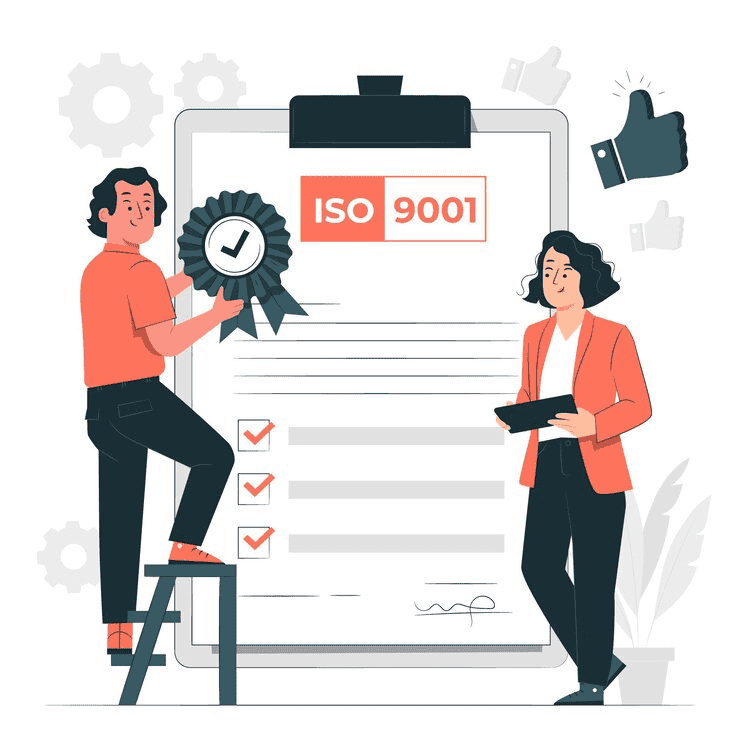When you hear “ISO 9001,” you might think of something technical and out of reach for your business. But honestly, it’s much simpler—and more beneficial—than it sounds. At its core, ISO 9001 is about improving the quality of your business operations and making them smoother, more efficient, and more consistent. And who doesn’t want that?
If you’re running a business, whether it’s a small startup or a well-established company, the goal is clear: You want to run things in the most efficient way possible. The problem is, without a proper framework, operations can become chaotic. Tasks get missed, deadlines slip, and inefficiency becomes the norm. That’s where ISO 9001 comes in. Think of it as your roadmap for better organization, higher quality, and streamlined processes.
Let’s break it down. This guide will show you exactly how ISO 9001 can benefit your company, whether you’re in manufacturing, services, or any other field that thrives on high-quality output and satisfied customers. We’ll also go through the steps involved in implementing ISO 9001 and how to get the most out of it. By the end of this, you’ll have a clear understanding of why ISO 9001 isn’t just another certification; it’s a game-changer for boosting efficiency.
What Exactly Is ISO 9001?
Before we dive into how ISO 9001 helps you, let’s first understand what it actually is. ISO 9001 is part of the broader family of standards issued by the International Organization for Standardization (ISO). This specific standard focuses on quality management systems (QMS) and is applicable to any business, regardless of its size, sector, or geographical location.
In simple terms, ISO 9001 is a set of guidelines designed to help businesses maintain high standards in their processes, ensure customer satisfaction, and continually improve their performance. Think of it like a well-organized playbook for your business to follow.
It’s all about the process. Not just about delivering good products or services, but ensuring that everything in your business works together toward a common goal of quality and customer satisfaction. The idea is simple: If you can improve your internal processes, your final product or service will improve as well. This means fewer mistakes, faster delivery, happier customers, and ultimately—more profits.
Why Your Business Needs ISO 9001
1. Consistency is Key
We’ve all been there—businesses that don’t quite know what they’re doing next or departments that are constantly at odds. Without a solid framework, it’s easy to slip into chaos, and the end result? Inconsistent service, poor product quality, and a frustrated team.
ISO 9001 ensures that everyone in your organization is on the same page. When you implement this standard, you’re essentially setting up a consistent approach to processes that everyone will follow. Whether it’s your marketing team, customer service reps, or warehouse staff, they’ll all know exactly what’s expected and how to get there.
2. Customer Satisfaction: The Foundation of Everything
You probably don’t need a reminder, but happy customers are what keep a business running. It’s no surprise that ISO 9001’s primary focus is on improving customer satisfaction. By continually assessing and improving your processes, ISO 9001 helps you deliver products or services that meet or exceed customer expectations every time.
Let me explain how this works: The standard promotes a culture of feedback and continuous improvement. This means your business will always be adapting, whether that’s improving your product design, customer service, or operational workflows. The result? A loyal customer base and a reputation for reliability.
3. Boosted Operational Efficiency
Efficiency isn’t just about working faster—it’s about working smarter. With ISO 9001, you’ll identify areas where time, money, and effort are being wasted and find solutions to streamline operations. From reducing errors to automating processes, ISO 9001 helps you remove bottlenecks and inefficiencies across the board.
Imagine eliminating those frustrating delays and mistakes in your processes. How much more productive would your team be? How much more could you achieve?
4. Risk Management and Problem Solving
Nobody likes to think about the worst-case scenario, but ISO 9001 encourages businesses to plan for the unexpected. It asks you to identify potential risks and develop strategies to mitigate them. This proactive approach allows you to stay ahead of problems before they even arise, rather than scrambling to put out fires.
This doesn’t mean you’ll never face challenges. But with ISO 9001 in place, you’ll be equipped with a clear plan to address any issues that do come up—whether it’s quality control failures, supply chain disruptions, or customer complaints.
5. A Competitive Edge in the Market
In today’s market, businesses that can prove they follow internationally recognized quality standards are a step ahead. Whether you’re tendering for new contracts or seeking partnerships, ISO 9001 certification signals to potential clients that you take quality seriously and are committed to continuous improvement.
This can be a major differentiator, especially in industries where reliability and consistent delivery are critical.
How ISO 9001 Helps Streamline Processes
Now that we know why ISO 9001 is important, let’s talk about how it actually makes your business more efficient. This isn’t just a vague concept—it’s a set of actionable steps that you can follow to make your operations run like a well-oiled machine.
Standardized Procedures and Documentation
One of the core principles of ISO 9001 is documentation. When you implement this standard, you create a detailed and standardized approach to all your business processes. This is key for improving efficiency because:
- It reduces errors: If everyone follows the same procedures, there’s less room for miscommunication or mistakes.
- It makes training easier: New employees can quickly get up to speed by reviewing the documentation.
Continuous Improvement (The PDCA Cycle)
You know the saying “there’s always room for improvement”? ISO 9001 makes that a reality with its focus on continuous improvement. One of the standard’s fundamental concepts is the Plan-Do-Check-Act (PDCA) cycle. This cycle encourages businesses to:
- Plan: Identify areas of improvement.
- Do: Implement changes.
- Check: Monitor the effects of those changes.
- Act: Take action based on the findings to ensure sustained improvements.
Effective Communication and Collaboration
ISO 9001 isn’t just about written procedures—it’s also about fostering open communication. The standard encourages transparency across all departments, so everyone understands the bigger picture. This leads to better collaboration between teams, a deeper sense of accountability, and ultimately, more efficient execution.
The Steps to Implement ISO 9001 in Your Business
You might be wondering: “Okay, I get it. ISO 9001 sounds great, but how do I implement it in my business?” While the process can seem intimidating at first, it’s actually pretty straightforward. Here’s a quick overview of what to expect:
1. Leadership Commitment
ISO 9001 starts at the top. If your leadership team isn’t fully on board, the implementation process is bound to hit roadblocks. That means getting buy-in from your CEO, department heads, and key decision-makers. Once everyone is on the same page, you’re ready to get started.
2. Define Your Quality Policy and Objectives
What do you want to achieve with ISO 9001? Your business needs to establish clear quality objectives that align with your broader strategic goals. This could range from reducing production costs to improving customer satisfaction scores.
3. Conduct a Gap Analysis
Before diving into the full implementation, it’s crucial to evaluate where your business stands right now. A gap analysis will help you identify areas where your current processes fall short of ISO 9001 requirements. This gives you a roadmap for where to focus your efforts.
4. Create the Quality Management System
With your goals and gaps identified, it’s time to create or revise your QMS. This involves mapping out processes, establishing procedures, and documenting everything. The goal is to ensure that every aspect of your business contributes to a consistent, high-quality outcome.
5. Internal Audits and Reviews
Once your QMS is up and running, conduct internal audits to ensure everything is functioning properly. Regular reviews help keep the system on track and ensure continuous improvement.
6. Get Certified
The final step is to seek ISO 9001 certification. This involves having an accredited third-party auditor assess your QMS and confirm that it meets all the requirements of the standard. Once certified, you can proudly display your ISO 9001 badge, showing the world that you’re committed to quality.
The Bottom Line: Is ISO 9001 Worth It?
Absolutely. The benefits of ISO 9001 go far beyond just ticking off a certification box. This quality management system helps you streamline your operations, improve customer satisfaction, and foster a culture of continuous improvement. Whether you’re a small business or a multinational corporation, ISO 9001 is a proven way to enhance efficiency and maintain high standards.
So, what’s stopping you? If you’re serious about taking your business to the next level, ISO 9001 is a solid investment. It’s not just about following a set of rules—it’s about setting your business up for long-term success.
Ready to get started?















Leave a Reply